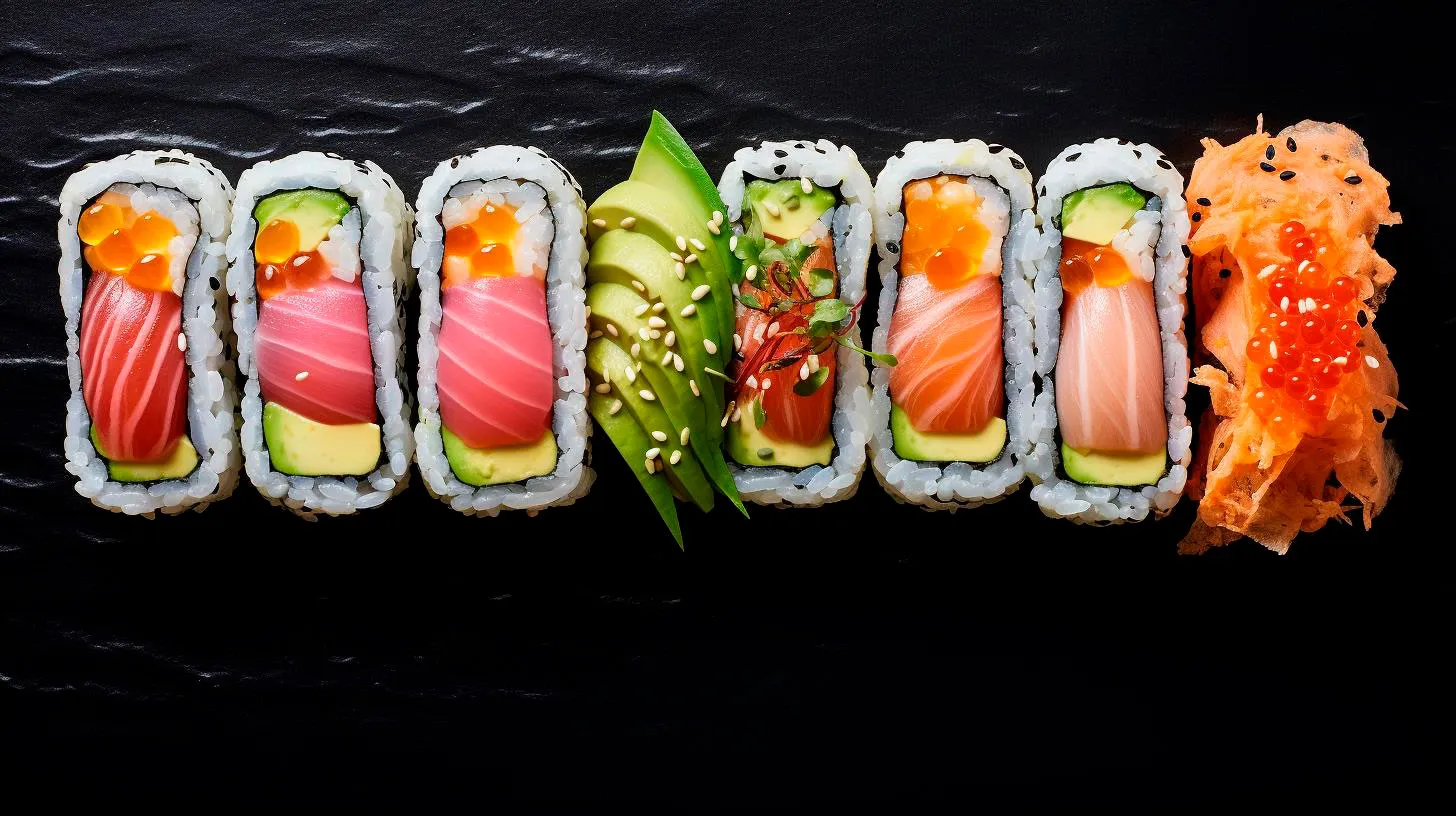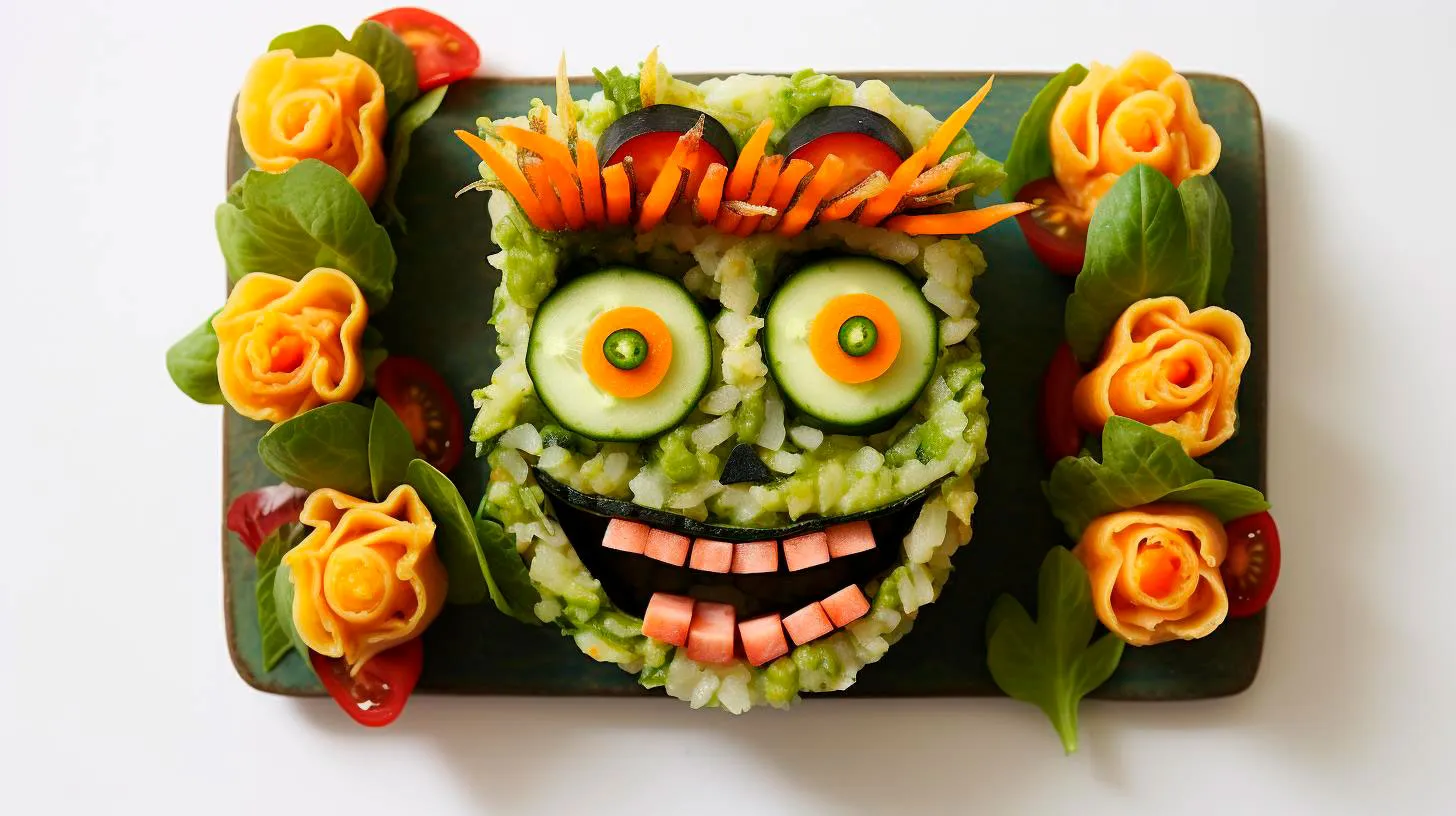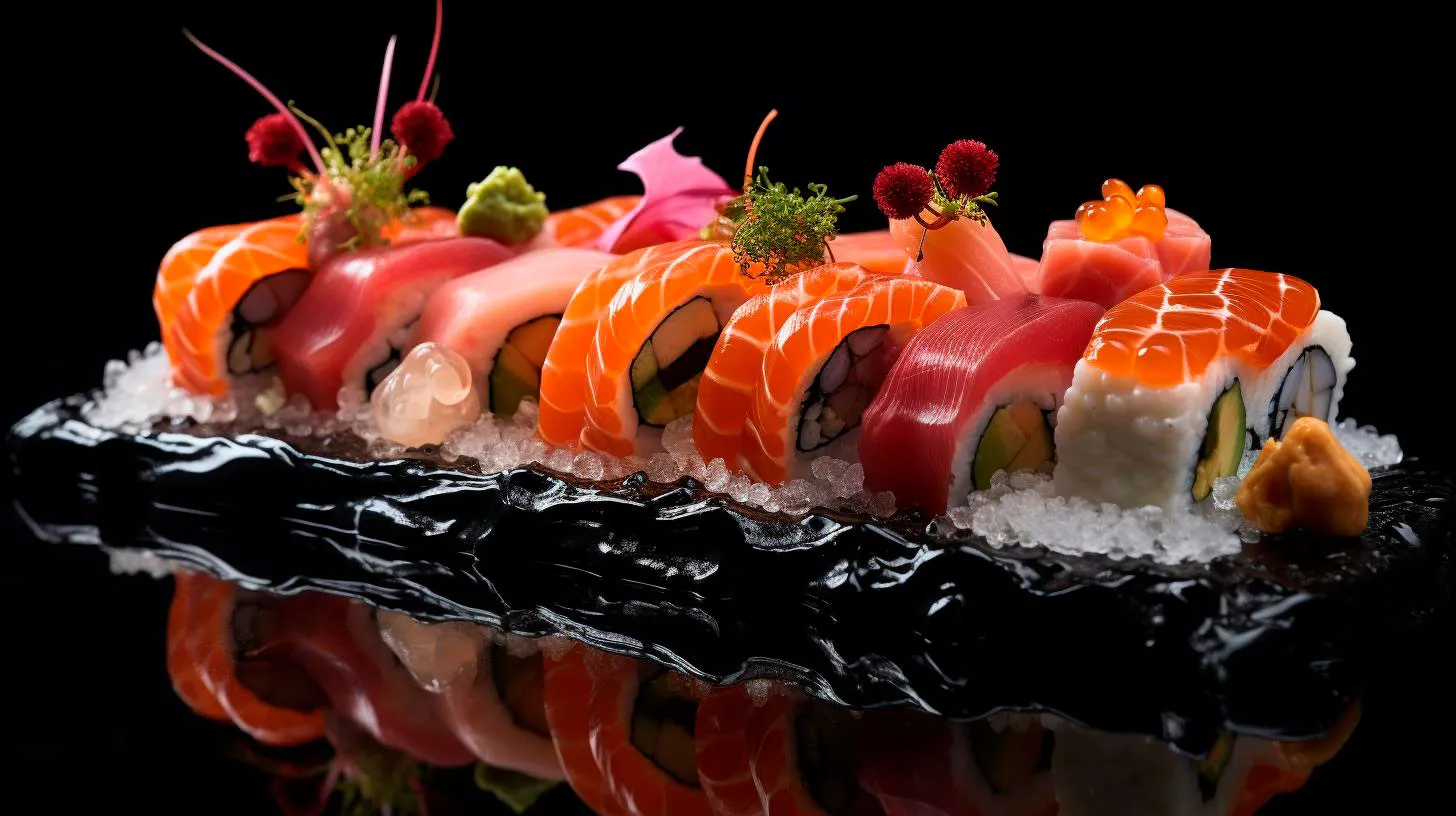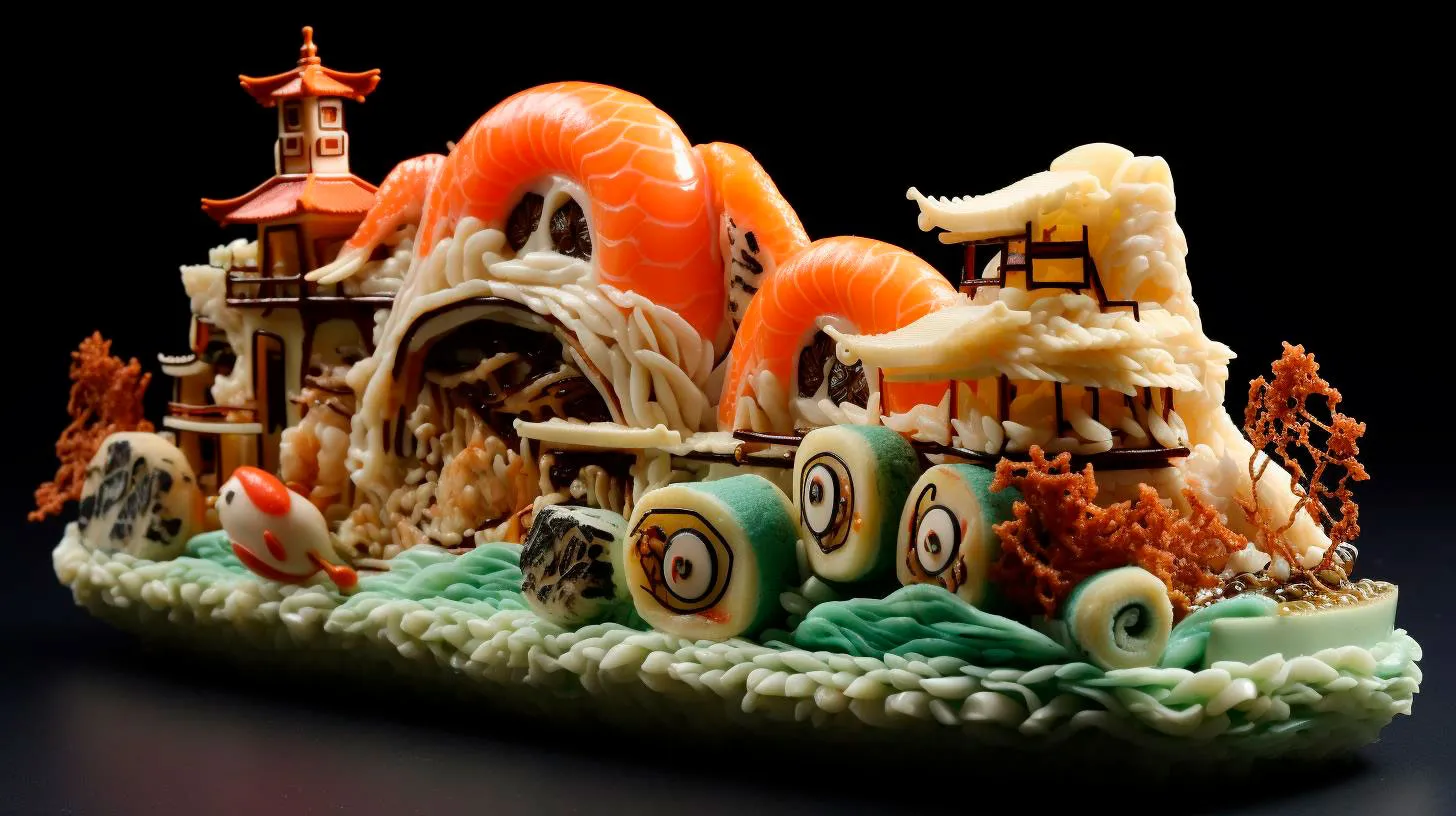Unraveling the Art of Sushi: An Exquisite Journey into Taste, Texture, and Presentation
In this article, we will dive into the mesmerizing world of sushi, exploring its origins, diverse types, and the key elements that make it an exceptional culinary experience.
Origins of Sushi
The origins of sushi can be traced back to ancient times in Southeast Asia, where it was primarily a method of preserving fish by fermenting it with rice and salt. Over centuries, this preservation technique evolved and reached Japan during the 8th century. Sushi then transformed into a delightful combination of vinegared rice, raw or cooked seafood, and a myriad of other ingredients.
Today, sushi has become synonymous with Japanese cuisine and has gained global recognition. Its popularity not only stems from its delectable taste but also from the artistry and precision involved in its preparation and presentation.
The Art of Sushi Preparation
Creating sushi is an intricate process that requires skill, precision, and an eye for detail. Here are the key steps involved in the art of sushi preparation:
- Selection of Fresh Ingredients: The success of sushi lies in using the freshest seafood, crisp vegetables, and high-quality rice. Sushi chefs meticulously source their ingredients to ensure the utmost quality.
- Rice: Sushi rice, known as “shari,” plays a crucial role in sushi. It is seasoned with vinegar, sugar, and salt, giving it a slightly tangy taste that perfectly complements the other ingredients.
- Slicing and Assembly: Sushi chefs carefully slice the ingredients and skillfully assemble them on a bed of sushi rice with the help of bamboo mats or their dexterous fingers.
- Knife Skills: The precise cutting technique used by sushi chefs, known as “nigiri,” ensures the perfect size and shape of each piece.
- Sauce and Garnish: Sushi is often accompanied by soy sauce, wasabi, and pickled ginger to enhance its flavors. Delicate garnishes such as radish, microgreens, or edible flowers add visual appeal.
Types of Sushi
Sushi is not a singular dish but a diverse world of flavors and styles. Some of the most popular types of sushi include:
- Nigiri: Nigiri sushi consists of a slice of raw or cooked seafood draped over a mound of sushi rice. It allows the flavors of the fish to shine while still offering a balanced combination.
- Maki: Maki sushi is a cylindrical-shaped roll consisting of sushi rice wrapped in seaweed (nori) and filled with various ingredients. It is then sliced into bite-sized pieces.
- Sashimi: Sashimi is not technically sushi, but it is often served alongside sushi. It consists of thin slices of raw fish or seafood and is appreciated for its pure and unadorned flavors.
- Temaki: Temaki is a cone-shaped hand roll with a seaweed wrapper filled with sushi rice, fish, vegetables, and other flavorful ingredients. It is a popular choice for its versatility and is often enjoyed as a handheld delicacy.
The Pleasures of Sushi Experience
Sushi is not just about satisfying your hunger; it is a multisensory experience that engages your taste buds, sight, and even your sense of touch. Here are some key takeaways that make sushi an extraordinary culinary adventure:
- Harmony of Flavors: The combination of fresh ingredients, savory umami flavors, and the delicate tang of sushi rice creates a harmonious taste experience.
- Unmatched Texture: From the softness of fish to the slight crunch of vegetables and the tender stickiness of rice, sushi offers a symphony of textures in each bite.
- Visual Delight: Sushi is known for its stunning presentation. The vibrant colors, meticulous arrangement, and artistic plating elevate the dining experience, making it a feast for the eyes.
- Nutritional Value: Sushi is not only delicious but also offers numerous health benefits. It is a fantastic source of lean protein, omega-3 fatty acids, and essential vitamins and minerals.
Key Takeaways
- Sushi is a traditional Japanese delicacy famous for its unique flavors, textures, and delightful presentation.
- The art of sushi preparation involves selecting the freshest ingredients, skillful slicing, and meticulous assembly.
- Popular types of sushi include nigiri, maki, sashimi, and temaki.
- Sushi offers a multisensory experience through its harmonious flavors, diverse textures, visually pleasing presentation, and nutritional benefits.
Embark on a culinary journey and indulge yourself in the art of sushi. With each bite, discover the rich heritage, skillful craftsmanship, and the exquisite flavors that make sushi a cherished delicacy around the world.
Delighting the Senses: Culinary Adventures through Unique Flavors
In this article, we will dive into the world of delightful flavors and the experiences they can offer.
1. The Power of Flavor
Flavors shape our perception of food and contribute to our overall dining experience. They are a combination of taste, aroma, texture, and presentation that create a sensory symphony. Whether it’s the sweet and tangy combination of tropical fruits or the complex blend of spices in an Indian curry, flavors add depth and excitement to our meals.
Key Takeaway:
- Flavors enhance our dining experience and make each bite memorable.
2. Exploring Global Cuisine
Global cuisine offers a vast array of unique flavors that reflect diverse cultures and traditions. From the spicy and aromatic dishes of Southeast Asia to the rich and hearty flavors of Mediterranean cuisine, there is a world of culinary delights waiting to be explored.
By venturing beyond our comfort zones and trying new dishes, we can expand our flavor repertoire and gain a deeper understanding of different cultures. Culinary tourism has become increasingly popular, with travelers seeking authentic food experiences as they explore new destinations.
Key Takeaway:
- Exploring global cuisine allows us to discover new flavors and immerse ourselves in different cultures.
- Culinary tourism offers a unique way to experience a destination’s culture through its food.
3. Fusion and Hybrid Cuisine
Fusion and hybrid cuisine have gained popularity in recent years, blending flavors from different culinary traditions. These innovative combinations offer a unique twist on traditional dishes, creating exciting culinary adventures.
For example, the fusion of Japanese and Peruvian cuisine has given rise to Nikkei cuisine, which combines the freshness of Japanese ingredients with the bold flavors of Peruvian spices. This fusion has created a whole new world of unique and delicious dishes, such as tiradito (a Peruvian-style sashimi) with a tangy yuzu sauce.
Key Takeaway:
- Fusion and hybrid cuisine offer exciting combinations of flavors, providing unique and memorable dining experiences.
- Nikkei cuisine is an excellent example of fusion cuisine, combining Japanese and Peruvian flavors.
4. The Rise of Experiential Dining
In addition to flavors, the overall dining experience has become a crucial factor for many food enthusiasts. Experiential dining goes beyond the plate and incorporates elements like ambiance, presentation, and storytelling into the meal.
Restaurants are increasingly focusing on creating immersive experiences for their guests. This can range from dining in complete darkness to being served a meal on a hanging platform high above the ground. These unique experiences not only delight the senses but also create lasting memories.
Key Takeaway:
- Experiential dining offers an immersive and memorable experience that goes beyond just the flavors.
- Restaurants are incorporating elements like ambiance and presentation to enhance the dining experience.
5. Wellness and Flavorful Eating
As people become more health-conscious, there is a growing demand for flavorful yet nutritious options. The wellness industry has embraced the concept of mindful eating, focusing on nourishing the body and delighting the senses simultaneously.
Chefs and food enthusiasts are exploring ways to create dishes that are both healthy and flavorful. This has led to the development of innovative cooking techniques and the use of natural, wholesome ingredients to enhance the taste of dishes without compromising on nutritional value.
Key Takeaway:
- Wellness-focused eating emphasizes the importance of nutritious and flavorful meals.
- Innovative cooking techniques and natural ingredients can enhance the flavors of healthy dishes.
Delighting the senses through culinary adventures is a journey of exploration and discovery. By embracing global cuisine, fusion dishes, experiential dining, and wellness-oriented meals, we can embark on a flavorful adventure that engages all our senses. So, let’s savor every bite, appreciate the intricate flavors, and let food take us on a remarkable journey around the world.
Influencers Showcasing Sushi Aesthetic Delights and Gastronomic Wonders
In this article, we will explore how influencers are showcasing the sushi aesthetic delights and gastronomic wonders, and how it has become a trend on social media platforms.
1. A Visual Feast: Sushi as Art
Sushi, with its beautifully arranged ingredients and vibrant colors, is a visual feast for the eyes. Influencers have recognized this artistry and are using their platforms to capture and showcase the beauty of sushi. With carefully composed photographs and videos, they highlight every intricate detail of this delicacy. From the precision of the knife cuts to the precise placement of garnishes, influencers capture the essence of sushi as an edible work of art.
- Instagram has become a hub for sushi influencers, with dedicated accounts amassing thousands of followers.
- By utilizing professional photography techniques, influencers create stunning visuals that elevate the sushi experience.
- These visuals not only showcase the aesthetics but also serve as a source of inspiration for sushi enthusiasts to try new sushi recipes or visit sushi restaurants.
2. Fusion of Tradition and Creativity
While sushi is deeply rooted in Japanese traditions, influencers have found creative ways to push the boundaries and experiment with different flavors and ingredients. By blending traditional sushi-making techniques with modern influences, they create unique and exciting sushi creations that captivate their followers.
- The fusion of flavors and ingredients appeals to a wider audience, bridging the gap between traditional sushi lovers and those willing to try something new.
- Influencers collaborate with sushi chefs and restaurants to showcase their skills and introduce innovative dishes.
- Through their experimentation, influencers inspire others to step out of their comfort zones and explore the endless possibilities of sushi.
3. Sushi for Health and Wellness
Sushi is not only a treat for the taste buds but also a healthy dining option. Influencers are leveraging this aspect to promote the health benefits associated with sushi consumption. By highlighting the use of fresh seafood, nutrient-packed vegetables, and low-fat ingredients, they emphasize how sushi can be a part of a balanced diet.
- Sushi is rich in omega-3 fatty acids, which have been attributed to various health benefits, including improved heart health.
- Influencers educate their audience on the different types of sushi and their nutritional profiles.
- By showcasing sushi as a healthy alternative to other indulgent foods, influencers encourage their followers to make mindful choices when dining out.
4. Socializing and Community Building
The sushi trend has also given rise to a thriving community of sushi enthusiasts who share their love for this gastronomic delight. Influencers play a crucial role in nurturing this community by engaging with their followers and creating a sense of camaraderie.
- Influencers organize meetups and sushi tasting events, bringing together sushi lovers to bond over their shared appreciation of this cuisine.
- They encourage their followers to share their own sushi experiences and creations, fostering a sense of belonging within the community.
- This community aspect not only strengthens the bond between influencers and their followers but also contributes to the overall promotion and appreciation of sushi as a culinary art form.
Key Takeaways
Sushi has transcended its culinary origins to become a source of inspiration, creativity, and community-building on social media platforms. Influencers have harnessed the visual appeal, fusion of flavors, health benefits, and community spirit surrounding sushi to attract a wide audience. By showcasing sushi as an art form and a delightful feast for the senses, influencers continue to drive its popularity and introduce new people to the wonders of this Japanese delicacy. So the next time you’re scrolling through your favorite social media platform, keep an eye out for the sushi influencers who are showcasing their aesthetic delights and gastronomic wonders.
Sushi from Different Perspectives: Exploring Cultural, Artistic, and Innovative Creations
The Cultural Significance of Sushi
Sushi holds a special place in Japanese culture, reflecting the country’s deep-rooted traditions and meticulous craftsmanship. Understanding its cultural significance helps us appreciate the artistry involved in creating a sushi masterpiece.
- Traditional Techniques: Sushi-making techniques have been passed down through generations, preserving the authentic flavors and textures that define this delicacy.
- A Symbol of Respect: The way sushi is presented and consumed in Japan reflects a deep sense of respect for the ingredients, the chef, and the overall dining experience.
- Seasonal Ingredients: The use of seasonal ingredients in sushi showcases Japan’s respect for nature and the ever-changing flavors it offers.
- Kaiseki Influences: Sushi is often served as part of a formal kaiseki meal, which emphasizes balance, harmony, and reverence for the culinary arts.
The Artistic Appeal of Sushi
Sushi is not only a delicious dish but also an artistic masterpiece. Every element of a perfectly crafted sushi roll or nigiri is thoughtfully designed to create an aesthetically pleasing and visually enticing experience.
- Colorful Presentation: Sushi chefs meticulously arrange ingredients to create vibrant and visually appealing presentations that stimulate the senses before the first bite.
- Balance and Symmetry: The precise placement of ingredients and the meticulous shaping of sushi demonstrate the importance of balance and symmetry in Japanese art and design.
- Edible Art: Sushi chefs often incorporate intricate designs and patterns using various ingredients, showcasing their artistic skills and elevating sushi to a level of culinary art.
- Minimalist Beauty: The simplicity of sushi’s presentation highlights the beauty of each ingredient, allowing them to shine individually and collectively.
Innovation in Sushi
While sushi has deep roots in tradition, it has also embraced innovation, leading to exciting and unique creations that push the boundaries of flavor and technique. Sushi chefs around the world continue to experiment and infuse their own cultural influences into this beloved dish.
- Fusion Sushi: Combining traditional Japanese techniques with flavors from other cuisines has given rise to fusion sushi, creating a harmonious blend of flavors that cater to diverse palates.
- Vegetarian and Vegan Options: Sushi has evolved to offer a variety of options for those following vegetarian or vegan diets, showcasing the versatility and adaptability of the dish.
- Creative Ingredient Combinations: Sushi has expanded beyond the conventional seafood options and now includes innovative combinations like fruit, tempura, and unique sauces, appealing to adventurous eaters.
- Delivery and Takeout: Advancements in technology and packaging have made sushi accessible for delivery and takeout, allowing people to enjoy this delicacy from the comfort of their homes.
Key Takeaways
Sushi is much more than a dish; it is a cultural, artistic, and innovative representation of Japan’s culinary heritage. In summary:
- Cultural Significance: Sushi embodies traditional Japanese techniques and values, highlighting the seasonal ingredients and the art of presentation.
- Artistic Mastery: Sushi’s visually appealing presentations and the attention to detail showcase the artistry involved in its creation.
- Innovative Creations: Sushi has evolved to include fusion flavors, vegetarian options, and creative ingredient combinations, catering to a wide range of tastes and preferences.
Next time you savor a piece of sushi, take a moment to appreciate the cultural heritage, artistic beauty, and innovative spirit that are intertwined in this culinary masterpiece.



